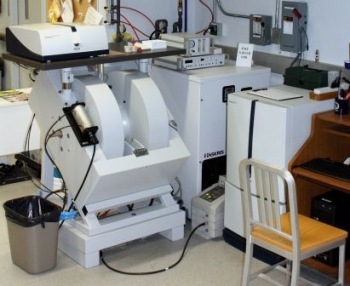
The Bruker EMXplus Spectrometer System uses EPR (Electron Paramagnetic Resonance) which is a very useful and powerful technique for studying samples that are paramagnetic (i.e. have unpaired electrons). Applications of EPR include:
|
|
Spectrometer Features:
- Microwave Frequency Range: CW X-Band (9 - 9.8GHz)
- X-Band Solid State Ultra Low Noise Microwave Bridge
- Max leveled source output: 200 mW
- Max. attenuation: 60 dB
- Tuning range: 60 MHz
- Integrated Bridge Controller w/ real time display for optimizing parameters
- Digital Ultra High Resolution Hall Field Controller
- Operating Range: 100 G - 18 kG
- Sweep Range: up to 0 - 18 kG (0 - 1.8 mT) in one scan
- High Linearity Modulation Amplifier Module: 500 Hz - 120 kHz
- X-Band High Sensitivity EPR Resonator (Bruker ER 4119HS-LC)
- Q > 15,000
- Optical window for photoactivated experiments
- Up to 10mm sample tube access
- Max. modulation amplitude: 20 G
- Automatic cavity tuning and matching
- X-Band Dual Mode EPR Resonator (Bruker ER 4119DM)
- Allows investigation of allowed and forbidden EPR transitions
- Parallel and Perpendicular mode operation
- Up to 10mm sample tube access
- Max. modulation amplitude: 10 G at 100 kHz
- Compatible with helium and nitrogen variable temperature units
- AquaX and Flat Cell accessories for aqueous samples
- Nitrogen and Helium cryostats for variable temperature and low temperature experiments, respectively
- ENDOR Probehead w/ freqency range of 1 - 100 MHz
- Programmable Goniometer for aquiring spectra at different orientations of the applied magnetic field with respect to the sample
- Simulation Software: XSophe
For full specs from the orginal quote click here EPR Specifications
Experiments:
- Room Temperature
- Time Scans - for kinetics studies
- 2D - a second parameter, such as, power or temperature, can be varied
along with the magnetic field - Cryogenic Experiments:
- Variable Temperature using liquid N2
Range: 100K - 700K
Sample Tube Requirements: Only O.D. = 4mm or 5 mm - Low Temperature using liquid He
Range: 4K - 100K
Sample Tube Requirements: Only O.D. = 4 mm
- Variable Temperature using liquid N2
- ENDOR - Electron-Nuclear DOuble Resonance
Advanced notice of 2 weeks must be given to Shamon Walker if cryogenic experiments wish to be performed because cryogens must be ordered and the system has to be prepared/setup.
If ENDOR experiments wish to be performed, please make an appointment with Shamon Walker.
EPR sample tubes are made out of quartz due to it being free from most paramagnetic impurities. NMR tubes can be used if the signal from the sample is strong, however, since they are made out of Pyrex, an iron peak may be seen in the spectra if the sample's signal is weak.
To purchase EPR sample tubes, click on the following link:
Wilmad Labglass - EPR Sample Tubes
Training
Everyone must first be trained for the Room Temperature Experiments before moving on to cryogenic and/or ENDOR experiments. Please fill out the EPR Training Request Form and indicate which experiment(s) you would like to do (room temp, VT w/ liq. N2, or VT w/ Helium) in the comment box.
Lab:
Contact:
Please contact Shamon Walker if you have any questions, comments, or concerns.
